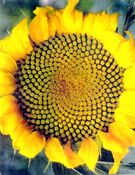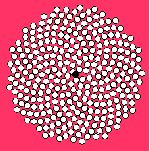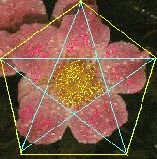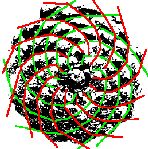
The diagram on the right shows an abstract version of this pattern. Maybe you'll find it easier to count those spirals over there.

 |
These sunflower seeds seem to be arranged in 34 spirals opening clockwise.
But you can also see spirals going the other way. Question: how many? Further
down on this page, you'll get a chance to submit your answer.
The diagram on the right shows an abstract version of this pattern. Maybe you'll find it easier to count those spirals over there. |
 |
The numbers involved in many such patterns form an interesting sequence:
3,5,8,13,21,34, ... which is named after the medieval mathematician Leonardo
da Pisa, nicknamed Fibonacci.
Can you figure out how the sequence continues?
 |
Lilies have 3 petals, wild roses have 5. Pinecones often have 8 spirals going up one way, 13 the other way -- and there many other examples. Why do plants pick on the Fibonacci numbers? One theory is that they are really trying for the Golden Ratio, whose connection to the Fibonacci sequence is well known and understood. |  |
But why would leaves and seeds strive for the Golden Ratio? There still
is no consensus on the answer. It's one of the riddles of what biologists
call
phyllotaxis.
The more we know about the life of plants, the better we understand our
own. As you can see, mathematics is involved right in the centre of this
quest for understanding.
Mathematics is everywhere.
This contest is now over. There are two correct answers
this time. If you count the tightly wound spirals near thhe centre you
get 21, if you go
for the more open spirals starting at the rim you get 55. So this sunflower
displays three consecutive Fibonacci numbers: 21, 34, 55. The winner of
the draw was Pam Liem of Vanvouver. Thanks to all participants! Please
try again on the next one (featuring the violin).
The Pacific Institute for the Mathematical Sciences (PIMS)
is a non-profit organisation supported by five universities of Western
Canada and dedicated to the promotion of mathematical research -- but it
also has a programme of education
and public awareness.